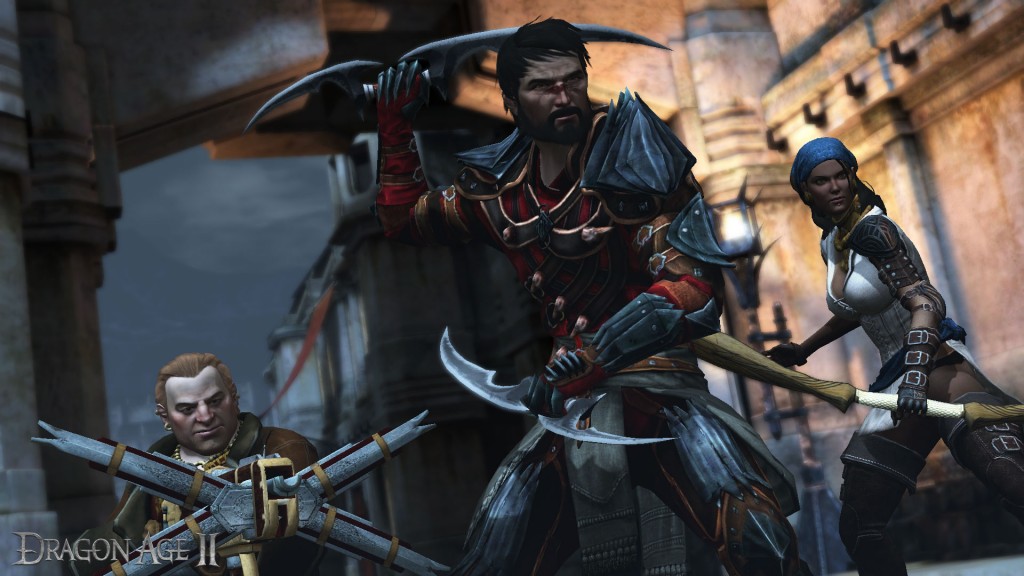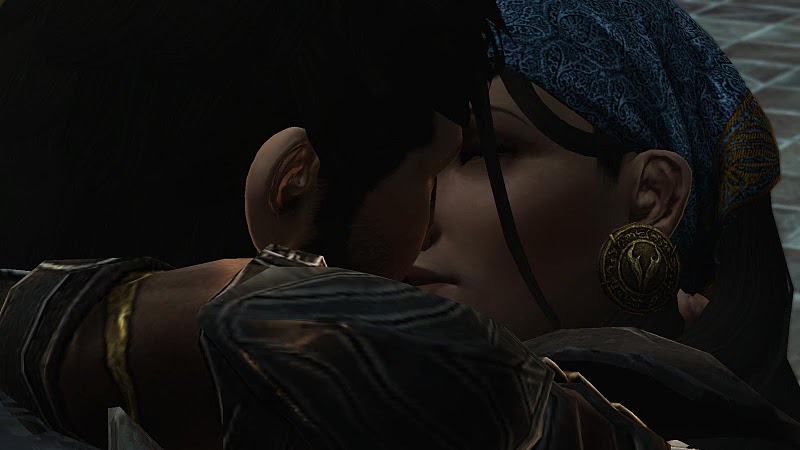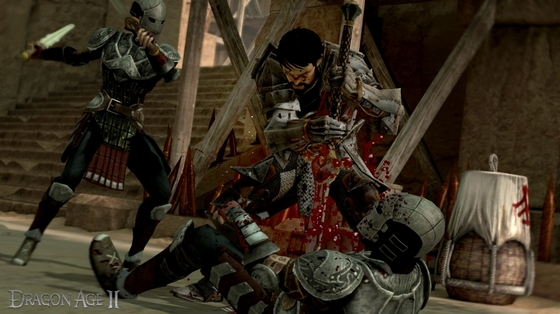This post has not been edited by the GamesBeat staff. Opinions by GamesBeat community writers do not necessarily reflect those of the staff.
Garrett Hawke: Warrior, mage protector and all around good guy who happens to like romancing two women at once. This is the character I experienced Dragon Age 2 with, a game that does the Dragon Age series proud — even if it isn’t as good as Dragon Age: Origins.
Dragon Age 2 is quite a bit different than its prequel, Origins. For starters, BioWare didn’t make the protagonist (Garrett Hawke if you’re a male) a no name hero that only talks when you pick his dialogue strings — he’s a full fledged voiced character with his own background and story.
Players lead Hawke and his family out of Blight ridden Ferelden to Kirkwall, a vast city once full of slaves and riddled with brutal history and even more brutal streets.
As an immigrant you’ll first experience Hawke’s hardships trying to earn money, protect his apostate sister (a mage not watched over by the Chantry, a religious group that holds significant power) and follow him as he rises through the ranks to become a nobleman, fight off a Qunari invasion and settle a bloody mage revolt against the Chantry and its Templars (the military branch of the Chantry used to keep mages under lock and key).
Dragon Age 2 is unique in that all of these elements are told in a framed narrative, or a story within a story. Unlike the first game, there isn’t one big bad guy looming just out of view that you are working towards defeating.
This is what makes the sequel so powerful and important: it sets itself apart from Origins and also sets the stage beautifully for Dragon Age 3.
I won’t get too deep into the story as not to ruin too much, but I will say this: the way BioWare intertwines the three main acts so that underlying quests feed into story elements down the road is genius, and the amount of foreshadowing will keep Dragon Age fans on the edge of their seats wanting more.
The sequel is a full, lengthy game, but it feels like an intermission, or a calm (if calm is Qunari uprising and mage revolts) before the storm type of adventure before what one can only expect to be a larger, more epic Dragon Age 3. Randomly meeting Grey Wardens who must leave to fight something great than murderous Qunari; extra story information in the codex hinting at future plot elements; meeting the returning Origins characters; the ending involving both the Origins main character and Hawke; mention of the one, very special talking Darkspawn from the expansion, Awakening… if given the time and resources, Dragon Age 3 is going to be one hell of an epic on the scale of Lord of the Rings or Harry Potter.
But all of this foreshadowing would not matter if players weren’t able to get through a good tale in Dragon Age 2, and that tale is a good one fraught with loss, revenge, love and friendship.
Family is a big part of the game. Garrett escapes to Kirkwall with his mother and sister (or brother depending on what class you are) and tries to make a new life. To witness the hardships and bond of this family is a nice change of pace from all the adventures that throw characters into a save-the-world scenario with random strangers. Sadly, it doesn’t last.
I really wish your mother and sister would have had more impact (spoiler: I did what was necessary for my sister, Bethany, to happily be around for the remainder of the game and rejoin me as a party member.) If Bethany is with Garrett and you side with the mages, you do get a good bit of dialogue with her at the end of the game, but I wanted more. You lose site of the family over the seven years the game takes place in because of specific story events that are out of your control.
The family aspect may deteriorate, but your companions more than make up for it.
Your friends or rivals will come and go in your home; you’ll fall in love with them, help them out and even help them to court others.
One character that stands out is Aveline, a tough soldier who fought for King Cailan in the ill-fated battle of Ostagar in the beginning of Origins. She travels from Ferelden with you to Kirkwall and becomes guard captain. To be with her over the course of the game and help her and have her aid you in various missions give a very sincere sense of friendship. Heck, at one point you help her court a lover — one of the funnier things I’ve seen in a video game.
In fact, this relationship is probably the most believable in the game; it’s basically what one would expect from best friends. You’ll both be flirty, chatty, appreciative, and helpful. The way they interact makes it seem like they were best friends since birth — quite the feat in any game.
What’s more important is that your companions aren’t always with you; they live their own lives in their own homes and go about their business. They will, however, always be there if you call on them (and don’t mess up certain quests, which could result in losing certain characters forever.)
Dragon Age 2 uses a rivalry and friend meter to gauge how companions feel about Hawke. It is interesting in that it really doesn’t matter which way it goes. Of course, someone who wants to be a good guy will aim for happy friendships with their companions.
Apathy, however, seems to be much worse than rivalry because it eliminates the possibility of romance with characters and prevents players from making a major story choice. I became friends with everyone (and romanced a certain pirate lady with full friendship) but I was also able to lead a fine relationship that led to romance with the ditzy Dalish elf, Merrill — even though her rivalry was maxed out. It’s definitely a different way of doing the good and bad meters found in games.
Speaking of characters, the return of some Origins ones isn’t just fan service — they’re really important to the story and part of that whole foreshadowing I mentioned before. The problem is, I was almost more interested in going with them and finding out what they were doing. Dragon Age 3 can’t come quick enough.
As you can tell, story and characters mean the most for me in a video game. Dragon Age 2’s are wonderful and come together in a great way. The way some things come full circle will surprise players.
But enough of that, how will players smite enemies?
Well, it’s not much different than how you smited baddies in Origins: you have a button for your regular attacks, special moves that take time to recharge and a party backing you up in what can only be described as an action RPG with tactical elements.
The major change is how visceral the combat is. Battles are fast, and battles are bloody. You can literally hit the attack button and watch as Hawke dashes across the battlefield to smack enemies with a hammer or whatever your weapon of choice may be. Players also don’t have to worry so much about assigning tactics to party members either; they get the job done without any tinkering for the most part.
Equipment is slightly different as well. Most characters can equip weapons and accessories. However, armor can only be equipped to your main character with everyone else’s dependent on buying upgrades for their armor or finding them in chests or on enemies when you loot their dead bodies. It’s actually not a bad way of handling armor, but those who like to obsess over every little thing in their RPG may dislike it.
That isn’t a bad thing as there is a lot to obsess over to begin with. I completed every quest and beat the game in 62 hours. There’s a good number of side quests, but with that comes a lot of recycled dungeons.
This is probably the game’s major fault. For the most part the side quests are fun and rewarding, but if so many assets were going to be reused — resulting in me running through carbon copy dungeons, caves and mansions — why not cut half of it and use it to make a new area? I like having missions to save mages from the Fade, stop blood mages from cutting up bodies and go spelunking in caves, but I’d like to do it in some new areas from time to time. This is a similar problem Dragon Age: Origins had with downloadable content.
Much like any RPG, the amount of side quests you complete will result in how much enjoyment the game gives you, especially in the story department. Just make sure to have Anders (from Awakening) tag along when you meet Nathaniel (also from the expansion), Leliana and King Alistair… if you didn’t kill him or banish him from your original playthrough. It will be most rewarding.
That character interaction is pretty rewarding, but it’s both a curse and a gift. If you have the right party member at the right time they will add valuable dialogue and speak of past adventures or shared experiences. If you happen to not have the right character, you miss out on some good bits.
The graphics and music are both top notch. The music is stirring, epic and never just a little background melody. The rapturous singing met with powerful sounds is a perfect fit for the massive adventure the game aims to be.
Graphically the game is crisp and detailed. Character hands, however, look like Dumbledore’s in Harry Potter when one of them ends up looking black and dead. I still can’t believe I let Isabela and Merrill touch me with hands that look like that.
The art style also deserves mention. Elves no longer look like slightly smaller humans; they have distinct faces and noses. Qunari also don’t look like Shaquille O’neal; they are gigantic and have horns.
Aside from the reused dungeons, I would pinpoint only two more problems: glitches and the last battle.
Glitches in the game pose no major issues, but they will prevent achievements from popping up, and screw up the order of story sequences in Merrill’s companion quests, which is annoying but doesn’t affect anything in a major way.
The last battle is more a personal qualm. It gets a little too JRPG for me in that it’s just a little unbelievable. I can take magic, Darkspawn and demons, but I draw the line at statues coming to life and end bosses practically jumping higher than Superman used to before he could fly.
On a final note, the ending is both satisfying and disappointing.
The ending does more for the third game than it does for the second. It doesn’t bring a very good conclusion to the character’s stories. The main hero and his love (loves in my case) seem to run off with the hero of Ferelden whereas everyone else is an unknown. However, this vague ending could work in BioWare’s favor, as it will give quite a bit of wiggle room when lead writer David Gaider gets cracking on the third game.
Final comments:
Dragon Age 2 is different than Origins, but it’s still damn good. Seeing the story come full circle and evolve in the second game is a treat, and seeing decisions made in Origins and Awakening turn into quests, be mentioned throughout and actually make valuable changes to your Dragon Age 2 experience is an even bigger treat. Fans of the series will eat it up, but those who want to start at the second game will want to give Origins a play first to better understand the world, lore and better appreciate the story.
Rating: 9/10 









The Good: The foreshadowing will psyche fans up for the third game. Different kind of narrative.
The bad: Reused assets for dungeons.
The Ugly: Glitchy quests and graphics.




